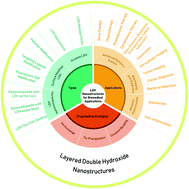Layered double hydroxide nanostructures and nanocomposites for biomedical applications
Abstract
Layered double hydroxide (LDH) nanostructures and related nanocomposites have attracted significant interest in biomedical applications including cancer therapy, bioimaging and antibacterial treatment. These materials hold great advantages including low cost and facile preparation, convenient drug loading, high drug incorporation capacity, good biocompatibility, efficient intracellular uptake and endosome/lysosome escape, and natural biodegradability in an acidic environment. In this review, we summarize the development of three types of LDH nanostructures including pristine LDH, surface modified LDH, and LDH nanocomposites for a range of biomedical applications. The advantages and disadvantages of LDH nanostructures and insights into the future development are also discussed.

- This article is part of the themed collection: Recent Review Articles


 Please wait while we load your content...
Please wait while we load your content...